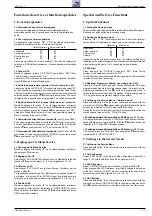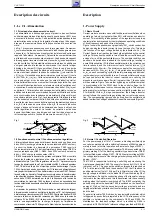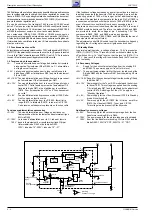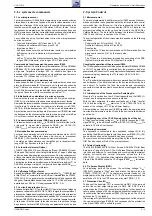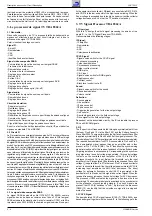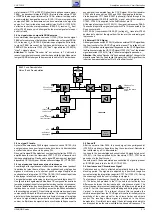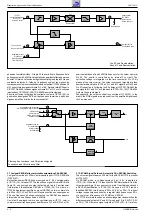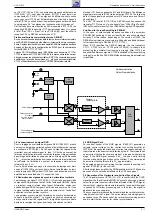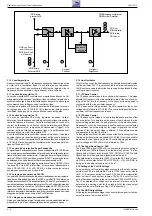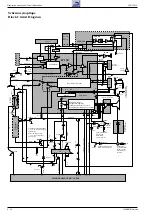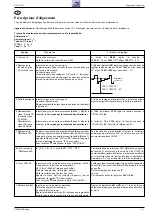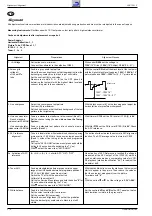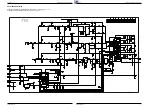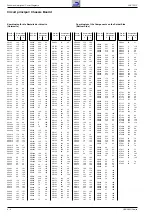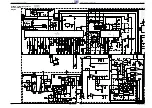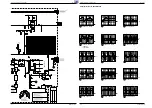
GRUNDIG Service
2 - 6
CUC 7301 F
Description des circuits / Circuit Description
Ton ZF und Demodulation
Sound IF and Demodulation
Filterung des Luminanz- und Chrominanzsignals
Luminance and Chrominance Filter
Ton ZF +
Lautstärkeregelung
Sound IF +
Volume Control
HPF
PLL
Demodulator
LPF
Ungeregelter
Ton Scart
Uncontrolled
Sound to Scart
Deemphasis
Geregelter Ton
Controlled Sound
Ton von Scart
Sound from Scart
Schaltsignal vom
Prozessor
Switching Signal
from Processor
5
6
16
50
1
Ton ZF und Demodulation
Sound IF and Demodulation
LPF
phase de l’oscillateur vidéo. A la pin 35 le quartz fixe la fréquence de la
porteuse couleur à 4,43MHz. La régulation du quartz est effectuée par une
boucle PLL interne. La tension de régulation est intégrée à la pin 33 via une
constante de temps. A l’aide de la porteuse couleur, les signaux de
composante couleur sont ensuite démodulés et quittent l’IC150 aux pins 30
et 31 sous forme de signaux chroma R-Y et B-Y. Après le retard PAL par le
CIC105 TDA 4665, les deux signaux chroma B-Y et R-Y sont à nouveau
injectés dans l’IC150-(28), -(29) TDA 8362A pour y être clampés.
Ensuite s’effectue le réglage du contraste couleur à l’IC150-(26). La
génération des signaux RVB est réalisée dans la matrice à partir des
signaux amplifiés à l’aide de la composante Y.
3.7 Le signal SECAM et la commutation automatique PAL-SECAM
Le signal chroma d'env. 300mV est disponible pour l'IC110-SECAM à
l'IC150-(27).
En fonctionnement SECAM, une tension de 5,6...5,8V est disponible
à l'IC110-(16). Lorsque l'IC110 a identifié un signal chroma SECAM à
la pin 16, une source de courant est activée à la pin 1 qui transmet
l'information d'identification SECAM à l'IC150-(32). De même, si
l'IC150 a également identifié un signal SECAM, celui-ci commute la
pin 32 sur 5V (1,5V en PAL).A cette tension continue on superpose en
PAL une fréquence d'horloge constante et en SECAM des paquets
d'impulsions d'une fréquence de 4,43MHz.
Ceci étant homologué comme une confirmation par l'IC110, celui-ci
commute les sorties des signaux de différence R-Y et B-Y (Pin 9 et 10)
quartz establishes a fixed 4.43MHz frequency for the colour carrier at
Pin 35. The quartz is controlled by an internal PLL circuit. The
correction voltage is integrated via the time constant at Pin 33. By
means of the colour carrier, the colour component signals are then
demodulated and leave IC150 as R-Y and B-Y signals at Pin 30 and
Pin 31 respectively. Following the PAL delay at CIC105 TDA 4665 the
two signals, B-Y and R-Y, are fed back to IC150-(28), -(29) TDA 8362
A where they are clamped.
Subsequently, the colour contrast is controlled at IC150-(26). In the
matrix, the RGB signals are produced from the amplified signals and
the Y-component.
3.7 SECAM Signal Path and Automatic PAL-SECAM Switching
The chroma signal of approx. 300mV for the SECAM-IC110 is present
at IC150-(27).
On SECAM mode, a voltage between 5.6V…5.8V is applied to
IC110-(16). When the IC110 identifies the SECAM standard, from the
chroma signal at pin 16, a current source at pin 1 is activated and sends
a SECAM identification to IC150-(32). As soon as IC 150 too has
identified SECAM, this IC sets pin 32 to 5V (1.5V on PAL). This direct
voltage is superimposed either by a regular clock frequency on PAL,
or by bursts at a frequency of 4.43 MHz on SECAM.
The IC110 interprets these as an acknowledgement and switches the
difference signal outputs R-Y and B-Y (pins 9 and 10) to 3.5V DC (1.5V
on PAL ). The difference signal outputs of IC150-(30), -(31) are thus
Filterung des Luminanz- und Chrominanzsignals
Luminance and Chrominance Filter
Schaltsignal vom Prozessor
Switching Signal from Processor
FBAS von HF
CCVS form HF
FBAS von Extern
External CCVS
Regelspannung für
die Calibrierung
Control Voltage
for Calibration
CH
Y
16
13
15
12
Farb-Trap
Colour Trap
Delay
Peaking
2dB
Autom.
Calibrierung
Auto Calibration
Farb-Filter
Chroma Filter
Farb-Limiter
Farb-Regler
Chroma Limiter
Chroma Control






